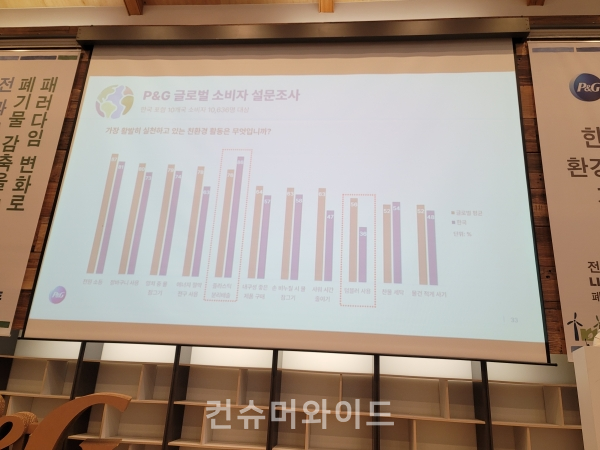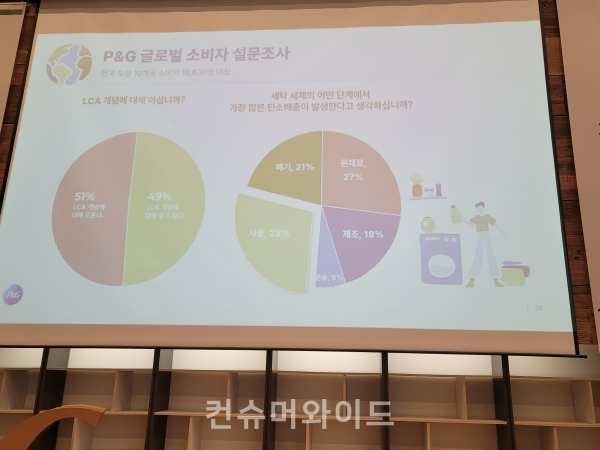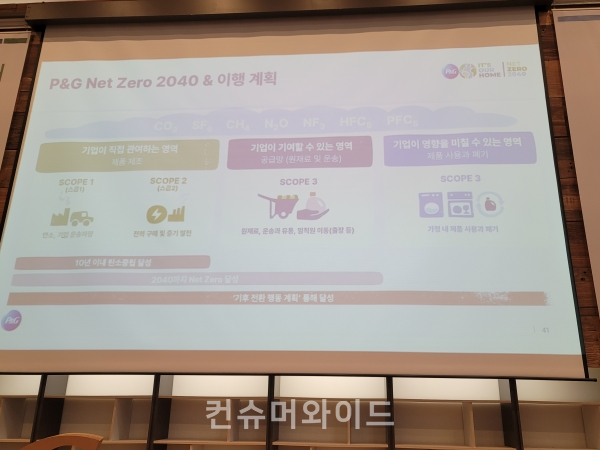
[Consumerwide_ HueSoung, Jun Reporter / Yohan, Bok Reporter] Ye Hyunsook, the ESG leader and cooperative headquarter director of Korea P&G, said during the ‘2023 P&G Korea environment sustainability press conference’ on the 25th at 10 a.m. at the Community House, Masil, in Junggu, Seoul. "P&G Korea has been faithfully taking responsibility for the last 34 years as a business citizen. In particular, we've been focusing on environmental sustainability, equal opportunities, embracement, and contribution in local society." On that day, Ye Hyeonsook, cooperative headquarter director, announced global consumer awareness and the efforts of P&G. Global consumer awareness is based on research that has been conducted in 10 countries with 10,000 consumers. The nation includes Korea, the USA, Canada, France, Germany, Hungary, and Chile.




According to the data mentioned during his speech, most countries see climate change, global warming, and water pollution as some of the most serious issues facing environmental sustainability, whereas Korea sees climate change and global warming as the first problem and disposal of plastic trash as the second. In addition, a large number of countries counted recycling and reducing trash as the top 1 and 2 activities for environmental sustainability, but Korea counted recycling and reducing disposable products. Regarding energy savings, other countries see it as the fourth priority, but Korea doesn't see it as important. Korea scored lower than average among 10 countries in most categories of eco-friendly activities, excluding trash recycling and cold water washing. In particular, tumblers (reusable water bottles) were used the least frequently.
Ye, the CHD, said, “It's ironic that Korea, which perceives using disposable plastic as the most important task, doesn't use tumblers frequently. I see that we are insufficient in terms of practice. In the 2020 research report, recycling practice was 71% different from this time (86%). Hence, I suspect that eco-friendly practice in Korea is advanced, but as for the rest of the area, training might be necessary. I observed that Korea is struggling between the will and practice of eco-friendly activities. 81% of people answered that they want to change to an eco-friendly lifestyle. But only 65% said that they practice."
Regarding what makes it most difficult to practice environmental sustainability, Korea answered that it is inconvenient to practice in the home environment (first) and that it isn't easy (second). On the other hand, most countries, including the US and Canada, answered that individual choices do not make much difference (first) and are uncomfortable to practice at home (second), which I found interesting. This is a part that shows it is crucial to figure out ways down to earth globally.
Korean customers are willing to pay more for eco-friendly products, and they also recognize that eco-friendly products can be costly. Nevertheless, 57% of Korean customers with experience with eco-friendly products have answered that they are not satisfied with the quality. In addition, 70% of customers won't purchase eco-friendly products if they lack quality. It can be interpreted as meaning that Korean customers want both quality and environmental sustainability in terms of purchase. From the research, Korean consumers understand the overall LCA (life cycle assessment) idea, but they seem to lack comprehension of fundamental principles. Among Korean participants, 49% answered that they knew the LCA concept. Yet, for detailed questions such as LCA in washing powder, not many understood them clearly. Hence, I didn't feel that they systemically understood LCA. Training for this particular area might be necessary.
In generational classification, there seemed to be not much of a gap between generations and nationalities in terms of willingness. However, in practice, there was a difference between Korea and the rest of the participating countries. While the MZ generation is leading the practice in most countries, Korea has the opposite flow. The parents' generation, who perhaps experienced post-war, was most up front, whereas the MZ generation was behind, which seems quite different from what the media presents.
Ye, the CHD of P&G, announced 'Netzero 2040' which targets emitting green gas to zero levels by 2040 on that day. This project aims to make a bigger change based on consumer feedback. Netzero means cutting the net emission to zero through balancing between green gas emissions, which cause the influence of global climate change, and absorption, which eventually results in the amount of green gas emission and absorption at the same level. Ye, the CHD of P&G, explained, "Aiming to make the idea a reality, we've been working it out from an LCA perspective. We analyze the entire process, from the point of resource supply to the point of waste. So that we may attain a product with an effective carbon emission reduction."

First of all, P&G is targeting to approach carbon neutralization by 2030 concerning green gas scope 1 and scope 2. Green gas scope 1 includes carbon emissions caused in the processes of transport and manufacture (maintenance and management), whereas scope 2 includes emissions generated during the electricity consumption and steam processes. They are pointing to 2040 for carbon neutralization for 'regular scope 3 upstream', the indirect emissions generated in the value chain process, which involves resources, freight, business trips, and commutes on a daily basis (from areas where businesses manage indirectly to areas relatively out of control). For scope 3 downstream, they are planning activities to turn the climate tide by cooperating with other businesses. The scope 3 downstream is an indirect green gas value caused by the overall value chain process. This project involves customer consumption and waste from areas where businesses manage indirectly to areas relatively out of control.
Ye, the CHD of P&G, said, "P&G products generate 12% of their carbon footprint in the product transportation and distribution process and 4.7% in the waste process. 83% of carbon is still generated in the customer consumption process. For this reason, we are trying to make more changes beyond Netzero throughout the entire process, from the point of resource collection to manufacture, production, packaging, and waste stages. Downy washing powder tries to make a 'clean powder' that is efficient in washing, even with cold water, while needing only a single rinsing. Additionally, they are putting effort into producing dry shampoo, which doesn't use much water in the process of shampooing. Throughout the entire process, we are encouraging our staff to develop and use products with clean processes, which include the process of consumption, that contribute to reducing greenhouse gas emissions. In this way, it can also fulfill our global customers' needs."
As Ye, CHD of P&G, emphasized in concluding the speech, "Our mission is for both current and future generations to benefit from a better environment. P&G and the brands will try and constantly provide information on how we can build a better earth through practicing small steps based on LCA in our home environment."
Meanwhile, P&G is speeding toward their '2030 ambition' by reducing green gas in their manufacture and supply processes while using recycled energy in 99% of their global manufacturing facilities currently. P&G has completed 79% of '100% recycle and reuse in packaging by 2030' goal. For the 'waste landfill zero' project, in which they collect 100% of waste from manufacturing factories, they've fully completed it. As for recycling, they are stretching out for innovative technology. 'Increasing water use efficiency by 2030' has been partially achieved (27%) at the moment. By recycling 3.1 trillion liters of water, they are enhancing the 'Supplying 5 trillion liters of water through resource recycling in manufacturing facilities' target. Besides, P&G is developing ingenious products that can reduce the use of water while storing more water in its global manufacturing facilities in 18 countries lacking water resources. Lastly, '100% recycled, reused, or new paper certified by a 3rd party by 2022', which aimed to maintain, restore, and grow forests, has reached 99.6% in time (2023 April). Globally, 35 countries are participating in the forest restoration project.

